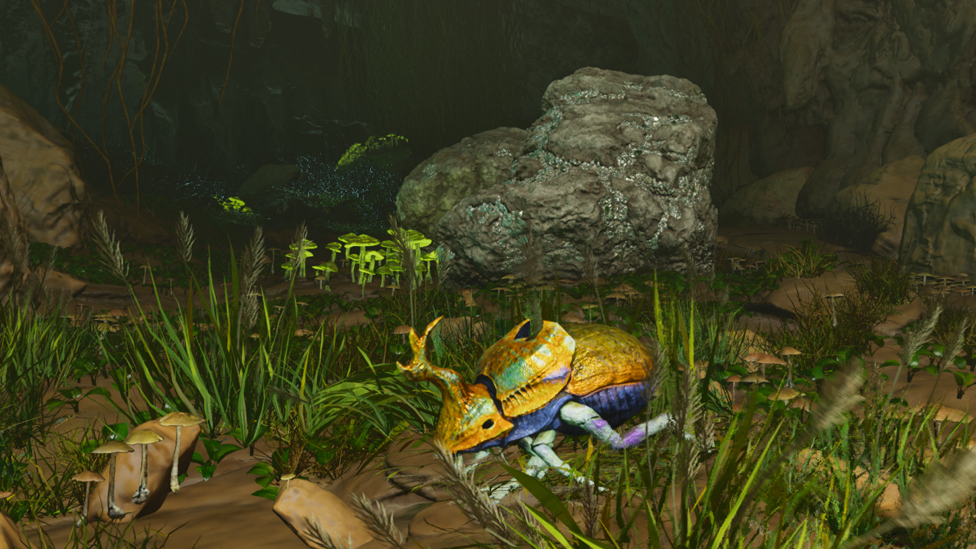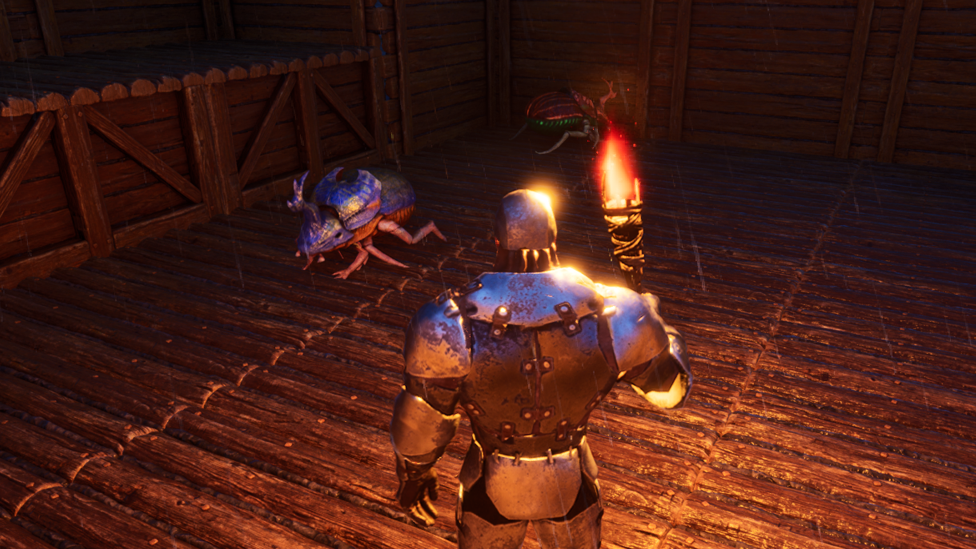ARK Survival Ascended How To Tame Dung Beetles
In ARK: Survival Ascended, survival is not just about avoiding dangerous predators. It’s also about gathering useful resources such as food and constructing strong base camps and shelters.
During your adventures, you will encounter many creatures, such as dinosaurs, sabertooths, and mutated spiders. However, the humble Dung Beetle is one of the most overrated insects. The insect is not a fearsome fighter but helps players grow crops and essential items by converting Feces into fertilizers and Oil.
Let’s dive into the steps for how to tame dung beetle Ark.
Where To Find Dung Beetles

Start Your ARK: Survival Evolved Server Today!
Dung Beetles are usually found crawling in different caves spread across The Island.
Lower South Cave
You should know that this is the easiest cave to find an Ark dung beetle in because there are fewer hostile creatures there.
Upper South Cave
Central Cave
North East Cave
Caverns of Lost Hope
If you are a beginner, we advise you to search for the dung beetle Ark in Lower South Cave. It is a less hostile cave than the other hostile ones.
Steps To Tame Dung Beetles In Ark: Survival Ascended
Taming a Dung Beetle might seem pretty simple on paper, but we have to consider the environment they're found in. Here's a step-by-step process to tame the insect:
Preparation:
Finding and Taming The Dung Beetle
After you have entered the cave, kill nearby threats for safety. Remember, Dung Beetles will stay non-aggressive unless provoked. This makes them pretty easy to approach.
You can start the taming process by isolating the Dung Beetle using Wooden Spikes or Fence Foundations with walls to stop the insects from interacting with creatures.
This is where the taming food comes into play. Take the collected Feces or Soiled Meat, place the quantity in the last hot-bar slot, and slowly approach the Dung Beetle. You can use the interaction key to feed the insect. Continue feeding the creature at intervals until the taming is done.
It is pertinent to mention that dung beetles can be carried in your hands while riding other creatures. Creatures such as Argentavis or creatures like Mammoths can also carry the Dung Beetles to your base.

How To Protect Them:
You can stop wild creatures from attacking Dung Beetles by building an enclosed or covered area for them at your base. This will keep them safe from aggressive beasts.
Our advice: Build the area such that they should be able to roam a little as it is essential for Feces gathering and conversion into ark fertilizer. You may like to keep them at a safe distance from creatures that could.
Moreover, health and inventory should be monitored at all times. These proactive measures would overload the dung beetles, allowing for the efficient production of fertilizer ark and oil. If taken care of, they can be indispensable help in farming or crafting.
When Do Dung Beetles Come In Handy
Don't mistake Dung Beetles as mere pets. They're productive creatures who come in handy. Here’s what they can do:
Feces to Fertilizer Conversion
Dung Beetles will convert Feces into Fertilizer and Oil when set to Wandering. Each type of Feces yields different amounts:
Automatic Collection:
Dung Beetles will automatically pick up Feces within a five-foundation radius when wandering, even if no other creatures are around.
Optimal Leveling:
You should focus on leveling up the Health and Weight of the Dung Beetles to make sure they can carry more Feces and survive in case of an attack.
Some Helpful Tips About Dung Beetle Uses:
Firstly, players should check their inventory regularly to avoid encumbrance, which can stop their production.
The Dung Beetles should be housed in an enclosed area where they can roam around while being close to your crops or Feces-producing creatures for maximum efficiency.

ScalaCube - Taking Online Gaming To New Heights
ScalaCube enhances the ARK: Survival Ascended experience with low latency, high-performance server hosting, and customization options. ScalaCube equips players with seamless gameplay, fast loading time, and reliable uptime for an enjoyable adventure. Ascended with low-latency, high-performance Ark Survival Ascended server hosting and customization features. ScalaCube allows for seamless gameplay, fast loading time, and reliable uptime for uncompromised survival. ScalaCube, it's the go-to solution for online gaming courtesy of our dedicated resources and multiplayer support options.
Wrapping Up
You'll have a good supply of Fertilizer and Oil if you follow the above-mentioned steps. This makes farming and crafting a lot easier. Dung Beetles are not that fancy, but we cannot deny their role in your survival and success in the relentless world of ARK: Survival Ascended.
Frequently Asked Questions
During your adventures, you will encounter many creatures, such as dinosaurs, sabertooths, and mutated spiders. However, the humble Dung Beetle is one of the most overrated insects. The insect is not a fearsome fighter but helps players grow crops and essential items by converting Feces into fertilizers and Oil.
Let’s dive into the steps for how to tame dung beetle Ark.
Where To Find Dung Beetles

Make Your Own ARK: Survival Evolved Server
Your own ARK: Survival Evolved server is only 5 minutes away!
Start Your ARK: Survival Evolved Server Today!
Dung Beetles are usually found crawling in different caves spread across The Island.
Lower South Cave
- Latitude: 80.2
- Longitude: 53.5
You should know that this is the easiest cave to find an Ark dung beetle in because there are fewer hostile creatures there.
Upper South Cave
- Latitude: 68.2
- Longitude: 56.1
Central Cave
- Latitude: 41.5
- Longitude: 47.1
North East Cave
- Latitude: 14.8
- Longitude: 85.4
Caverns of Lost Hope
- Latitude: 45.8
- Longitude: 88.9
If you are a beginner, we advise you to search for the dung beetle Ark in Lower South Cave. It is a less hostile cave than the other hostile ones.
Steps To Tame Dung Beetles In Ark: Survival Ascended
Taming a Dung Beetle might seem pretty simple on paper, but we have to consider the environment they're found in. Here's a step-by-step process to tame the insect:Preparation:
- Armor/Equipment: Caves are filled with hostile and aggressive creatures like Araneo and Onyx-T16. We recommend arming yourself with strong weapons, such as a shotgun or crossbow, and durable armor.
- Tamed Creatures for Defense: You can fight off these hostile creatures with your tamed animals. Stronger creatures such as the Sabertooth and Direwolf make a lot of difference in your survival and success.
- Luring Them With Food: You must think what do dung beetles eat Ark. The insects are passive tames and will eat Feces or Spoiled Meat. You can carry a stockpile of these items before taking a bug out. Phiomia Feces farms are very useful for this purpose.
- Bug Repellant (Optional): Dung Beetles are passive tames and the repellant will protect you from harm while you search for the insects in the cave.
Finding and Taming The Dung Beetle
After you have entered the cave, kill nearby threats for safety. Remember, Dung Beetles will stay non-aggressive unless provoked. This makes them pretty easy to approach.You can start the taming process by isolating the Dung Beetle using Wooden Spikes or Fence Foundations with walls to stop the insects from interacting with creatures.
This is where the taming food comes into play. Take the collected Feces or Soiled Meat, place the quantity in the last hot-bar slot, and slowly approach the Dung Beetle. You can use the interaction key to feed the insect. Continue feeding the creature at intervals until the taming is done.
It is pertinent to mention that dung beetles can be carried in your hands while riding other creatures. Creatures such as Argentavis or creatures like Mammoths can also carry the Dung Beetles to your base.

How To Protect Them:
You can stop wild creatures from attacking Dung Beetles by building an enclosed or covered area for them at your base. This will keep them safe from aggressive beasts. Our advice: Build the area such that they should be able to roam a little as it is essential for Feces gathering and conversion into ark fertilizer. You may like to keep them at a safe distance from creatures that could.
Moreover, health and inventory should be monitored at all times. These proactive measures would overload the dung beetles, allowing for the efficient production of fertilizer ark and oil. If taken care of, they can be indispensable help in farming or crafting.
When Do Dung Beetles Come In Handy
Don't mistake Dung Beetles as mere pets. They're productive creatures who come in handy. Here’s what they can do:| Type | Oil Amount Yielded | Fertilizer Amount Yielded |
|---|---|---|
| Small Animal Feces | 1 Oil | 1 Fertilizer |
| Medium Animal Feces | 2 Oils | 2 Fertilizers |
| Large Animal Feces | 3 Oils | 3 Fertilizers |
| Massive Animal Feces | 7 Oils | 16 Fertilizers |
Feces to Fertilizer Conversion
Dung Beetles will convert Feces into Fertilizer and Oil when set to Wandering. Each type of Feces yields different amounts:Automatic Collection:
Dung Beetles will automatically pick up Feces within a five-foundation radius when wandering, even if no other creatures are around.Optimal Leveling:
You should focus on leveling up the Health and Weight of the Dung Beetles to make sure they can carry more Feces and survive in case of an attack.Some Helpful Tips About Dung Beetle Uses:
Firstly, players should check their inventory regularly to avoid encumbrance, which can stop their production.
The Dung Beetles should be housed in an enclosed area where they can roam around while being close to your crops or Feces-producing creatures for maximum efficiency.

ScalaCube - Taking Online Gaming To New Heights
ScalaCube enhances the ARK: Survival Ascended experience with low latency, high-performance server hosting, and customization options. ScalaCube equips players with seamless gameplay, fast loading time, and reliable uptime for an enjoyable adventure. Ascended with low-latency, high-performance Ark Survival Ascended server hosting and customization features. ScalaCube allows for seamless gameplay, fast loading time, and reliable uptime for uncompromised survival. ScalaCube, it's the go-to solution for online gaming courtesy of our dedicated resources and multiplayer support options.Wrapping Up
You'll have a good supply of Fertilizer and Oil if you follow the above-mentioned steps. This makes farming and crafting a lot easier. Dung Beetles are not that fancy, but we cannot deny their role in your survival and success in the relentless world of ARK: Survival Ascended.Frequently Asked Questions
Is there a way to tame the dung beetle without having to enter any caves?
No, Dung Beetles only spawn in the caves in The Island. Lower South Cave is far less dangerous compared to a few of the other caves.
How do I protect Dung Beetles on my base?
Keep them in an enclosed area to protect Dung Beetles from wild predators. However, do not overcrowd their space, as they need room to wander.
Make Your Own ARK: Survival Evolved Server
Your own ARK: Survival Evolved server is only 5 minutes away!
Start Your ARK: Survival Evolved Server Today!
Copyright 2019-2025 © ScalaCube - All Rights Reserved.